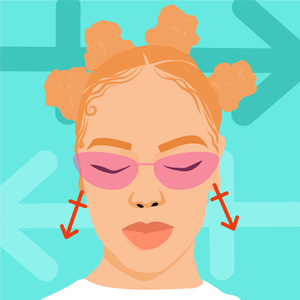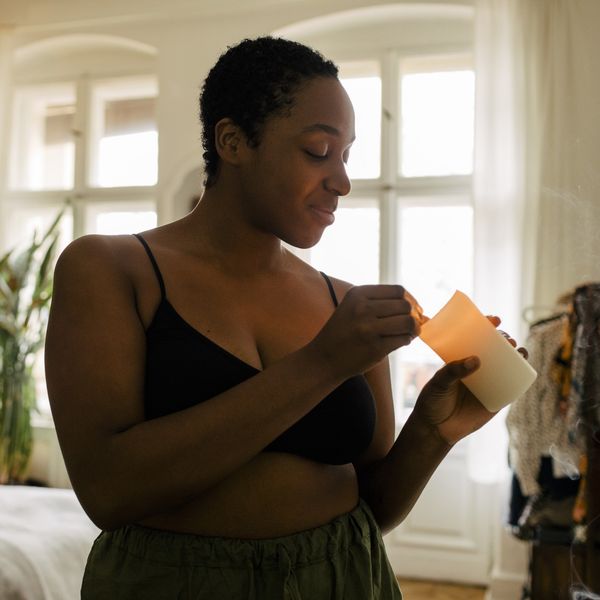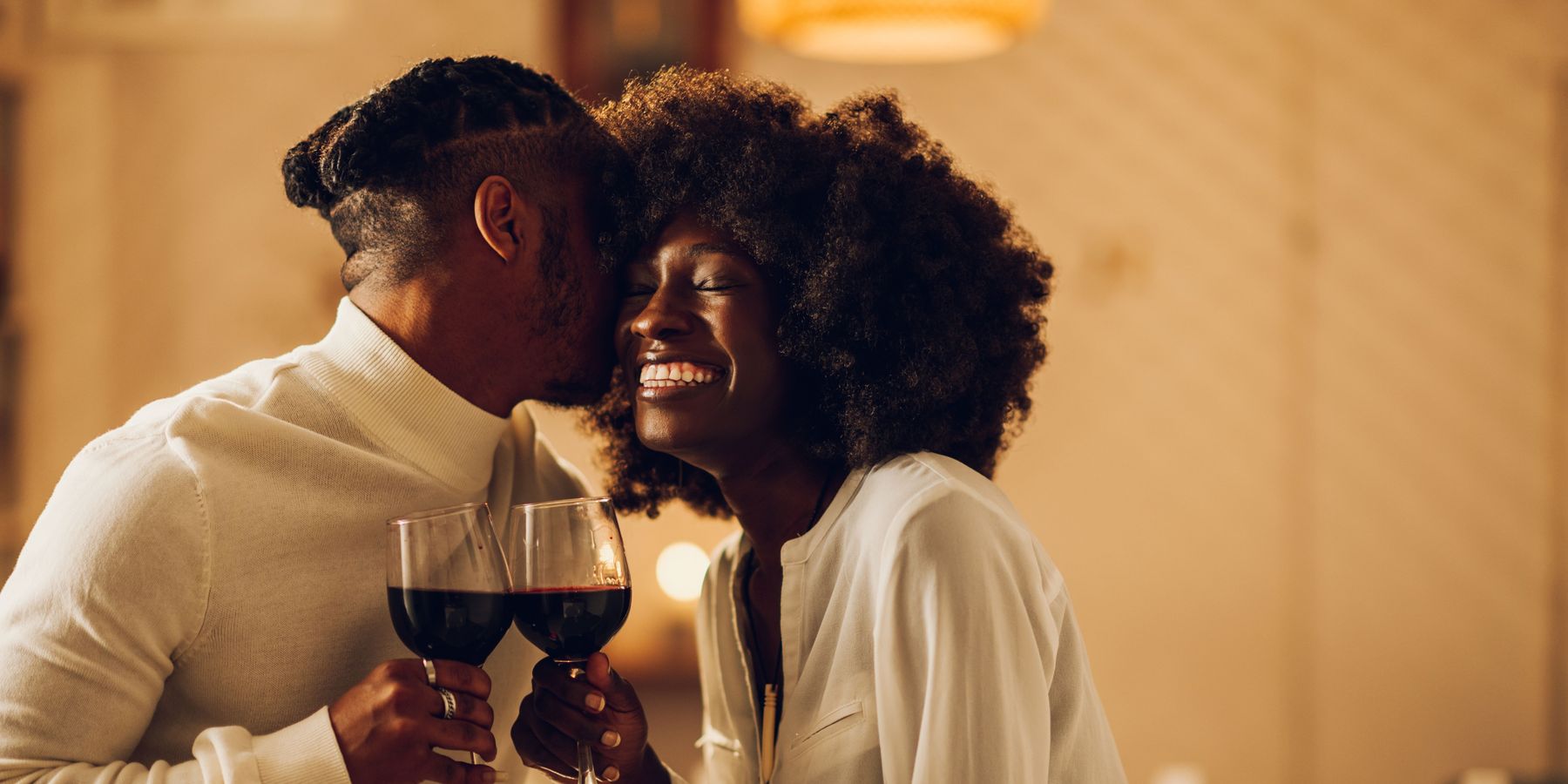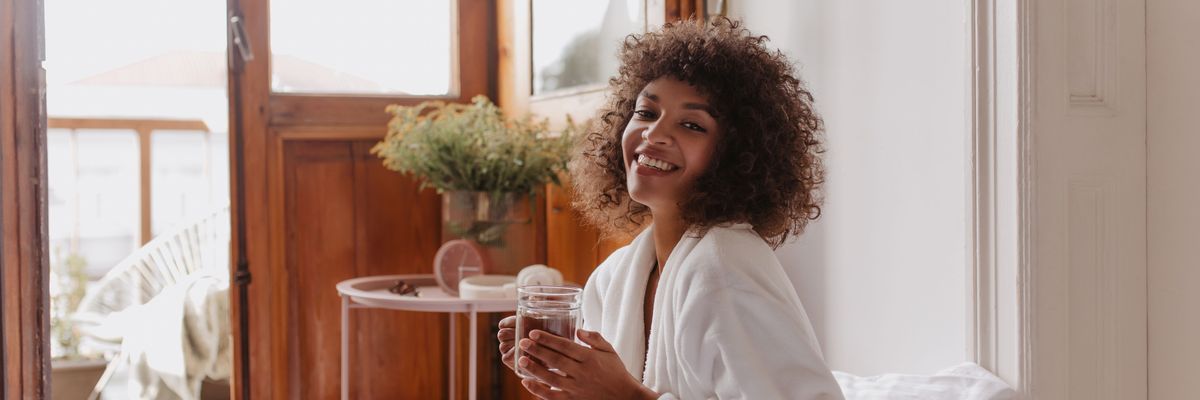
Adulting is hard but packing up and moving from one living space to the next is even harder. As a young adult, leaving home to attend college 300 miles away, I was yearning for a change of scenery so much so I couldn't wait to pack my belongings and head to sunny southern California. With each transition, it wasn't an easy task, however, nine years and 10 roommates later, I finally have a place to call my own. As liberating as it is to be in a space that's all mine, this move is unlike any other. As a single woman, the responsibility of uprooting myself has been more challenging than I ever imagined. More than just saving dreamy home decor inspiration via Pinterest, making "my house a home" has been a process that's easier said than done.
As a professional fashionista, I'm naturally inclined to all that is aesthetically pleasing. While I've always envisioned the type of space I want to come home to every day, over the years how I see myself and the world has evolved tremendously. At the ripe age of 31, I want a personal retreat from the outside world and I'm determined to curate a space that is comfortable, inviting, warm and luxurious. At this moment in my life, a safe and tranquil environment is my top priority, one that is true to who I am inside and out.
To be at peace, I want to surround myself with furniture and decor that speaks to what inspires me.
Our home should be a true reflection of who we are and who we want to be but that's difficult if we don't know ourselves. Creating the perfect ambiance can be challenging so I enlisted the help of aesthetic entrepreneur Antoinette Arrington to help those of us on our journey by focusing on what matters the most when filling our space. When I first reached out to Antoinette, I was determined to find out how I can decorate my new apartment on a budget but as I began to speak with her, I began to focus less on saving money and more on personalizing my experience.
As an interior stylist and home decor expert, Antoinette shares tips on key elements that will bring life to any living space as well as inside advice on getting the home decor items you want no matter the price.
What’s the first step when curating the perfect living space?
"My philosophy as an interior designer and stylist is that you live in a house but you are home. The things that you surround yourself with need to be an outward manifestation of where you've been or where you want to go. It's helpful to hone into who you are inviting into your space and share the results of your standards with because not everyone is going to get it and abuse it. My home doesn't have an open door policy, that's rule number one. If you're cultivating a space that inspires you towards your intentions, you don't have to lay out the welcome mat."

Antoinette Arrington, LA-based Interior Stylist & Founder of Haume
How can one avoid being overwhelmed when starting from an empty space?
"[Your living space] should be for you first and if you keep that in the forefront of your mind, that will influence how you shop and what you spend because luxury is subjective. Quality is how well something functions, luxury is how it makes you feel. Before shopping, you have to decide how you want a space to benefit you."
"Take your time in curating. Live in your home without any furniture for three months. Figure out where the light is, how your place sounds, how the temperature changes, and where you'll spend most of your time. Think of your perfect day and furnish that first."
"It may not be one room. It may be taking a hot bath, listening to music, and afterward putting on pajamas fresh out of the dryer and that you're climbing into bed wanting to watch a Netflix show so you buy bath sheets and make sure you have everything you need to enjoy a clean bathtub and a waterproof speaker. It also gets easier when those rituals start to change a bit, for example, going from a workout into the bath which may lead to investing in a corner of your home into a yoga studio or a gym. If you take the time to think of what you do, it's giving you an opportunity to figure out what you want. What's calling you?"
Speaking of shopping, any advice on how to avoid wasting money on items that we like at the moment but end up conflicting with the overall vision of what we want?
"The biggest waste of money is buying something because it's cute but it doesn't work or buying something that works but you have to hide because you don't want anyone to see it. That's how you end up with garages and closets full of clutter. Also, know that your home is an evolving space."
"What you like in this season may change. Don't shop with the idea that you have to keep something for 20 years because you don't. Think of it as a museum which curates art. The Mona Lisa bounces from place to place, she's there for a time and then she goes off to the next and it doesn't disrupt her legacy or the experience of the art."
"Changing your home decor is an ebb and flow. Don't walk in the store and buy the entire display or every trendy piece, take your time and curate your home. Trust your own voice and instinct. Don't search for validation for friends and family. If you like something, buy it and if you don't like it it's OK, be informed with the retailer's return policy."
Strategies for investing in high priced furniture?
"You need to be informed of what things cost, especially with COVID-19, like delivery and lead times. Also decide whether you want to assemble it because that goes into cost, everything can't be DIY. You need to buy your time back. Are you going to enjoy the thing you put together and it fell apart? Will you get frustrated and never finish? When making big purchases, looking into platforms like 'Handy' or 'Taskrabbit' are fairly inexpensive when putting together your furniture. Find someone experienced in a product that you bought and while they're there, have them put together a bunch of stuff. There are a lot of ways to make your money work for you."
How can we surround ourselves with luxury home goods within our budget?
"Deciding what you want your life to look like and who you are going to share or not share with helps set your budget. Go to your dream store, if money is no object, add everything to the cart as if you were going on a shopping spree then go look at the cart. That puts the object in the forefront. People tend to see something, fall in love with it but hear the price and decide they are not worthy. It's completely emotional, it may not even be that you don't have the money, it can be offensive just to see the price because they haven't made the connection between quality, luxury, and cost. [The key is] changing your mindset to '[I'm] investing in myself and my life and my experiences,' instead of, 'This couch is an investment.'"
Where do you shop for quality home decor?
"My couch is from Living Spaces and people don't believe me when I share the link. I routinely shop at Target, CB2, vintage, and Etsy. I don't own or wear anything that is exceedingly expensive, it's the combination of how you experience me that gives you the idea that I'm investing in myself. I go to HomeGoods for coffee table books and kitchen organization items, great national brands that are cheaper than other big box stores. They also have a great condiment and organic food section. You can find great lamps and rugs as well. Get to know your local store and ask when they restock. Introduce yourself to the manager so they expect you if you're looking for something. Bring a picture of what you're looking for. I like Costco, Sam's Club and Big Lots specifically for outdoor furniture."

Courtesy of Antoinette Arrington
What are some accents that can elevate your at-home experience?
"Art can be expensive, however buy your favorite prints for a fraction of a cost, go to Michaels or IKEA for frames or get the piece professionally framed. When it comes to oversized art, paint it yourself for an abstract piece. If you see art you like but don't like the frame, change it or repaint it."
"You can buy a nice set of dishes which are inexpensive at places like CB2 or Ikea. Vintage cutlery from Etsy or really cute forks from Target. Cloth Napkins from World Market or CB2 are a couple bucks. Glassware is not expensive at all, they can be $10. You can buy really nice inexpensive glassware from CB2. You can start small. If you really want a nice plate setting, do it for you and eat lunch on it every day. Buy yourself nice forks and a couple cloth napkins and a pretty plate. You don't have to use champagne glasses for just champagne. Make yourself accustomed to using nice things and normalizing it. You wouldn't go to Crustaceans and use paper napkins and plastic forks. Hotels have glasses on the counter for you, nice lotions and pretty soap, do that at home."
When seeking inspiration for the overall aesthetic of our place, how can we bring our ideas together into one cohesive look?
"Having a design plan, the colors and textures you like as well as what you're drawn to. If you saw something in a store and thought about it all night, hopping in your car early in the morning hoping it's still there, what would it be? Buy those things. If there's a place you want to travel to, research how people there live and what their days look like. If it was Tulum, I'd have a hammock in my living room and no one could say anything to me about it. A corner with a hammock and a bunch of plants that reminds me of Mexico."
"When you travel, bring back a piece of art, a cup, mask, pottery or wall hanging and display it in your home. You can share experiences with your guests. Your home should be ground zero for everything you need to be. You shouldn't have to code-switch in your house or put on armor. You should be exactly who you are. Recognize yourself first at home and then go out in the world and introduce yourself to her."
"If you don't know who you are, you're going to let everybody tell you who they think you are."
I bought a Fiddle Leaf tree recently however I don't want to go overboard with taking on too many new responsibilities at once. What is your advice for new plant moms?
"Be honest and be realistic. Go to a local nursery, not a hardware store, even if you don't buy anything, ask someone who is accustomed to speaking with clients about their inventory and is well-versed on the types of plants and the type of lighting in your house that will help you make an informed decision. Tell them about your lifestyle, if you have air conditioning, if you're home a lot, will the plant get fresh air or if you'll need a grow light. All pretty plants aren't care-free. I would suggest something as low-maintenance as possible for your first plant."
"You will have to invest in plant food, repotting, and making sure it's watered. Start with one, something small that you access a lot so that if it dies, you'll notice. If your perfect day is sitting around with 15 plants taking care of their leaves and repotting, if that's calming, go ahead and jungle out. If that's not your thing, get an artificial plant that looks real. You don't have to have plants in your home."

Courtesy of Antoinette Arrington
What are gems to keep in mind when making a house a home?
"There is no one combination of things that makes a house feel like home. It's a combination of happiness, intention, patience and investment that's going to make it feel like a home to you. You took the time, spent wisely, and you're living a life that incorporates all of your belongings. Do your due diligence when shopping for your home, you don't always have to fill an empty spot. No more cutting corners, have an abundance mindset when cultivating your space, but take your time! Filling your space too quickly can be a sign that there's something missing inside of you."
For more of Antoinette, follow her on Instagram.
Featured image courtesy of Antoinette Arrington
This Is How To Keep 'Holiday Season Stress' From Infecting Your Relationship
Hmph. Maybe it’s just me, but it seems like there is something really weird happening in the fall season air (because winter doesn’t officially begin until December 21) that cuddle season is in full swing while break-up season is as well. In fact, did you know that break-ups are so popular during the holiday season that December 11 is deemed Break-Up Day?
The reasons why relationships shift around this time vary; however, I did both roll my eyes and chuckle when I read that a very popular one is because it’s an easy way to get out of getting one’s significant other a Christmas present. SMDH.
Anyway, I personally think that the less shallow folks out here may contemplate calling things “quits” or they at least distance themselves a bit from their partner (and what I’m referring to is serious relationships) due to all of the stress and strain that oftentimes comes with the holidays whether it be financial, familial, due to their tight schedules or something else.
Listen, I would hate for you and your man to miss the fun and happiness of experiencing this time of year, all because you are so overwhelmed or irritated that you can’t really enjoy it. That’s why I have a few practical tips for how to avoid allowing the typical holiday season stress from INFECTING your relationship.
Manage Your Expectations
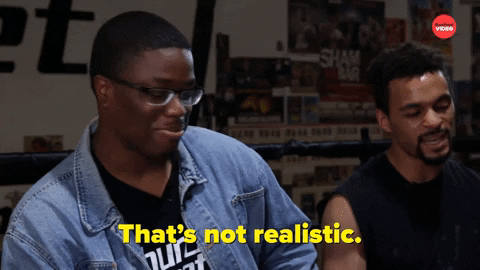 Giphy
GiphyUnmanaged expectations. If there is a main reason why the holiday season tends to be so stress-filled for so many people, I’d bet good money that this is the cause. And when you’re in a long-term relationship, expectations can manifest themselves in all sorts of cryptic and/or unexpected ways. You might have relatives who assume that you are going to be with them for Thanksgiving or Christmas when you have other plans in mind. You might be thinking that you are going to spend one amount for presents while your man is thinking something totally different. When it comes to scheduling, your signals may be crossed.
And you know what? To all of these scenarios, this is where clear and consistent communication come in. Don’t assume anything. Don’t dictate anything either. From now until New Year’s, mutually decide to check in once a week, just to make sure that you are both on the same page as it relates to the holidays and what you both are thinking will come along with it. The less blindsided you both feel, the less stressed out you will be. Trust me on this.
Set (and Keep) a Budget
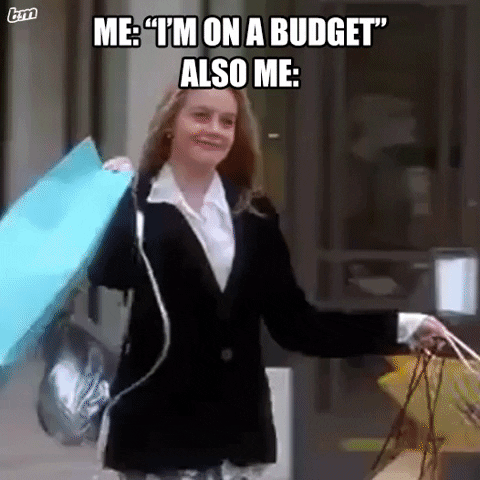 Giphy
GiphyOkay, so I read that last year, 36 percent of Americans incurred some type of holiday-related debt. Hmph. Last year, there was still some sense of normalcy in this country, chile, so I can only imagine what finances are gonna look like over the next several weeks. That said, since I don’t know a lot of people who don’t find being broke stressful, make sure that you and your bae set a budget and then stick to it this year — no ifs, ands or buts.
Because really, y’all — it doesn’t make sense to deplete savings and/or max out credit cards for a few days of giggles only to be damn near losing your mind because you don’t know how to make ends meet come Dr. Martin Luther King, Jr. Day.
And by the way, this tip doesn’t just speak to things like food and gifts; I also mean travel. If it doesn’t make a ton of sense (or cents) to be all over the place this year — DON’T BE.
Keep Matthew 5:37 at the Forefront
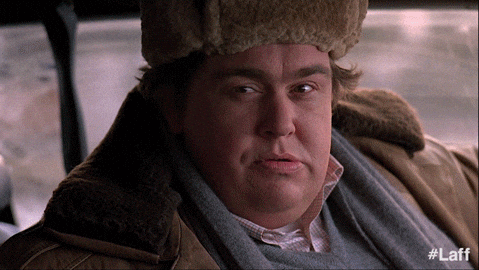 Giphy
GiphyIf off the top of your head, you don’t know what Matthew 5:37 says, no worries, here ya go: “But let your ‘Yes’ be ‘Yes,’ and your ‘No,’ ‘No.’ For whatever is more than these is from the evil one.” That verse right there? Oh, it’s a boundaries lifesaver! I say that because do you see “maybe” or “I’ll think about it” in there? Nope. LOL. It says that you should tell people “yes” or “no” and leave it at that — and that complements Anne Lamott’s quote, “’No’ is a complete sentence” impeccably well. Yeah, you’ve got to remember that anything beyond a yes or no to a request is privileged information; you don’t owe anyone details or an explanation.
Besides, if you are really honest with yourself, when someone asks you something and you give a “Umm, let me think about it” kind of reply, more times than not, you already know what your answer is going to be — so why not let you both off of the hook? Give your response. Commit to that. And let everyone (including yourself) get on with their lives and schedules.
I promise you that when it comes to those holiday parties, you are pissing more folks off by not RSVP’ing or doing so and not showing up than just saying, “Thank you but not this year” off the rip.
Remember That Your Personal Space Is Privilege Not a Right
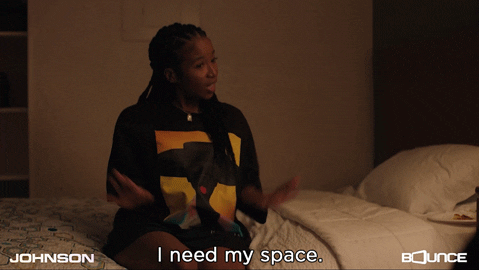 Giphy
GiphyA friend of mine recently bought a new house and invited me over to come see it. He’s a single man with no children, so as I was taking in all of the space that he had, especially as I walked through his finished basement, I joked about relatives coming to live with him. “Hell no” and “absolutely not” were pretty much his immediate responses as he went on to say that some folks even had the nerve to be offended when he told them that he had no intentions on taking DNA in.
Ain’t it wild how people think that your stuff is their right? And yes, that brings me to my next point. Your home is your sanctuary space. If you want to host folks this year — cool. If not, ALSO COOL. Please don’t let folks (family included) guilt you into how they want you to act or even into what they would do if the shoe was on the other foot. You are not them — and as one of my favorite quotes states, “If two people were exactly alike, one of them would be unnecessary.” (A man by the name Larry Dixon said that.)
Hell, my friends? They know that I am good for sending them random things that they need or even want all throughout the year. Coming over to hang out at my pace, though. Uh-uh. Chalk it up to being a card-carrying member of the ambivert club yet I like keeping my living space personal — and I sleep like a baby, each and every night, for feeling that way.
Always remember that your space, your time, your resources, your energy and shoot, yourself period (including your relationship), are all things that are your own. You get to choose how, when and why you want to share them. The holiday season is certainly no exception.
Cultivate Some “You Two Only” Traditions
 Giphy
GiphyIt’s not uncommon for some couples to hit me up after the holiday season to “detox.” Sometimes it’s due to the financial drama (and sometimes trauma) that they experienced. Sometimes it’s because they allowed their relatives (especially in-laws) to get more into their personal business than they should’ve. More than anything, though, it tends to be because they didn’t get enough quality time together and so ended up feeling “disconnected.”
Please don’t let that happen. Listen, I’m not even a holidays kind of woman and yet, I will absolutely sit myself down with some hot chocolate and chocolate chip cookies to enjoy a Hallmark holiday film or two. Aside from the fact that most of them are lighthearted and sweet, I also like that they usually focus on couples loving on each other amidst all of the holiday beauty and ambiance — which is something that all couples should set aside some time to do.
Maybe it’s a vacation. Maybe it’s a staycation. Or maybe it’s my personal favorite, A SEXCATION. Whether it’s for a few days, the weekend or even overnight — don’t you let the holidays go by without setting aside time for you and your man to celebrate one another. Don’t you dare (check out “Are You Ready To Have Some Very Merry 'Christmas Sex'?”).
GET. SOME. REST.
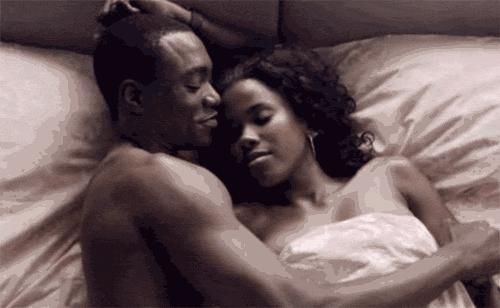 Giphy
GiphyI once read that 8 out of 10 people get stressed out over the holidays and 3 out of 10 lose sleep during to it — and when you’re stress-filled and sleep-deprived, that can absolutely lead to hypersensitivity, making mountains out of molehills and even not being in the mood for sex.
Your relationship can’t afford to go through any of this, so definitely make sure to prioritize rest. I don’t care how unrealistic it might seem during this time, sleep should never be seen as a luxury; it will always and forever be a great necessity.
That said, try to get no less than six hours of shut-eye in (check out “6 Fascinating Ways Sex And Sleep Definitely Go Hand In Hand”) and even ask your bae to take a nap with you sometimes (check out “Wanna Have Some Next-Level Sex? Take A Nap, Sis.”). Not only will sleep help to restore your mind, body and spirit but, when it’s with your partner, it’s an act of intimacy that can make you both feel super connected, even in the midst of what might feel like chaos.
___
Holiday season stress is real. Still, never give it the permission or power to throw your relationship off. Put you and your man first and let the holidays be what they are gonna be, chile.
Let’s make things inbox official! Sign up for the xoNecole newsletter for love, wellness, career, and exclusive content delivered straight to your inbox.
Featured image by Shutterstock
Whew. Did you know that somewhere around 122 million Americans travel during the holiday season? Listen, I went to see my godbabies this past September and got caught up in a crazy ass traffic jam at BNA (the Nashville airport) that damn near has me considering air travel ever again — especially during this time of the year.
Besides, it’s not like it’s a written rule that you have to travel over the holidays. In fact, if you want to play it chill this year, why not enjoy a staycation instead? Although it might seem like it’s a “poor man’s compromise,” as you’re about to see, it actually…isn’t.
1. Go All Out with the Christmas Décor
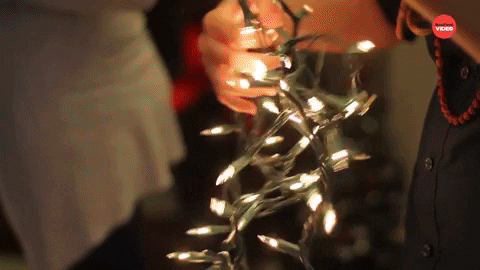 Giphy
GiphyThere is someone I know who is so obsessed with Christmas, she’s damn near annoying-borderline-terrifying. I’m. Not. Kidding. Yet hey, if you’re going to do a holiday-themed staycation (emphasis on “holiday-themed”), that’s kind of how you’ve got to be. Some décor ideas include:
- A fresh Christmas tree (is the most ideal) that is ultimately decorated
- Wreaths on outside and inside doors
- Garland (with twinkle lights) in predictable and unpredictable places
- Poinsettias
- Mistletoes
- Snow globes
- A stocking (with some of your favorite things in it)
- Fake snow
- Stars
- Angels
- Candy canes
- A BLACK Santa (LOL)
I mean, since you are going to be spending a lot of time at home, it can feel like a mini-winter wonderland if you are intentional about doing more decorating to your living space than you ever have before!
2. Buy a Couple of Christmas-Themed PJs
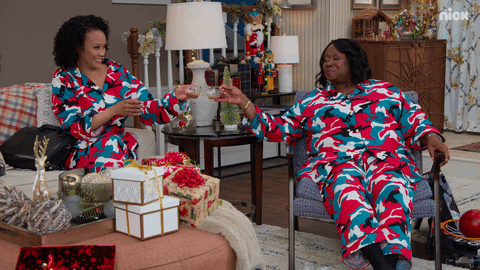 Giphy
GiphyWhile I was doing some research on a totally different topic, I happened upon an article that talked about the psychology behind why we should be intentional about what we wear to bed. When you stop to think about the fact that (hopefully) you are sleeping somewhere between 6-8 hours every night, it would make sense that things like the color and fabric of your sleepwear would have a real impact on you — even subconsciously.
Well, when it comes to Christmas décor, specifically, not only does it take you back to nostalgic memories, it can also boost your moods. So, aside from being on-10 with your Christmas décor, also invest in some Christmas-themed PJs. Since you’re going to be doing a lot of lounging around (RIGHT?), do it in something that makes you think about all of your favorite things about this time of year.
3. Cop Some Christmas-Scented Candles
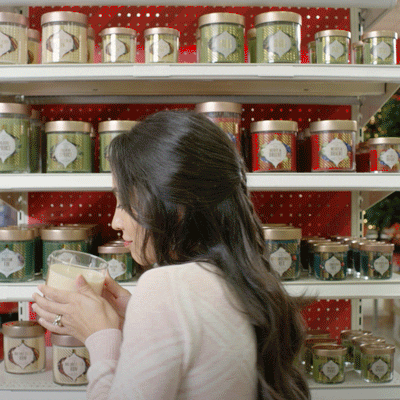 Giphy
GiphyThere really is no telling how many articles that I’ve written where I am singing the praises of scented soy candles. Candles are soothing, comforting and a very easy way to reduce stress. Also, since it gets darker quicker and for a longer period of time around this time of the year, candles provide a relaxing vibe to your home. Since it is Christmastime, go with scents that are reminiscent of the season:
- Cinnamon
- Vanilla
- Cranberry
- Apple
- Pine
- Frankincense and Myrrh
- Peppermint
- Cashmere
- Ginger(bread)
- Orange
- Sugar Cookies
- Sandalwood
- Cloves
- Cedarwood
- (Hot) Chocolate
Personally, one of my favorite candle companies is Goose Creek. Their signature collections will have your entire house smelling like a high-end bakery. No exaggeration.
4. Play Some Winter-Themed ASMR Sounds
 Giphy
GiphyI’m from Nebraska and my mother was a New Yorker. So, if there is one thing that I like, it’s seasons and that includes snow during wintertime. Unfortunately, Nashville is cray-cray when it comes to that. If, where you live, the weather is all over the place too (which is why I think it’s insane that some people still give pushback to global warming) and you would like for it to at least seem like you are in your own winter wonderland — invest in some fake snow to strategically place around your home.
Oh, and don’t forget to turn on some winter-themed ASMR sounds too. YouTube has videos that run for hours on end that feature blizzards and howling winds that really can make you feel like you are in the midst of an ice storm.
5. Host a Holiday Movie Marathon
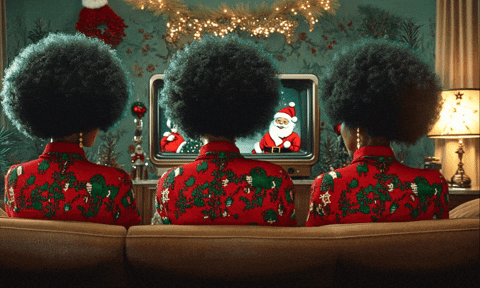 Giphy
GiphyOne thing to remember about a staycation is it doesn’t mean that you have to be alone or that the only people who can participate are the ones who live with you. Since a staycation is simply about staying close to home instead of traveling afar — absolutely consider having some of your favorite people over for a holiday-themed movie marathon. Shoot, Black America Web even did you a solid by publishing “25 Best Black Christmas Movies Of All Time;” plus, Tubi has a Black holiday hits section of indie films too.
Oh, and make sure to get creative with the Christmas-themed snacks. Some ideas? Some Kentucky-fried turkey tenders with cranberry hot sauce (recipe here), some Holiday Hot Spinach Dip (recipe here), some Grinch Kabobs (recipe here), some roasted pecans (recipe here) and some Pomegranate Guacamole (recipe here).
6. Spend a Night (or Two) at a Hotel or Vacation House
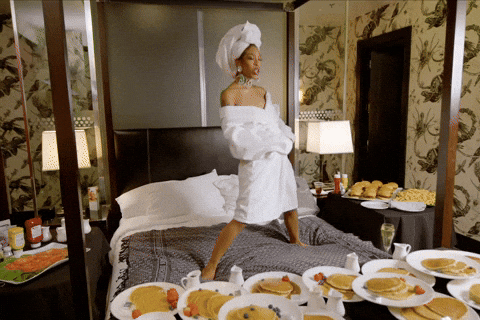 Giphy
GiphyJust like you don’t have to be alone during a staycation, you also don’t have to be cooped up in your house the entire time. Get a change of scenery in your own city by spending the night in a hotel that you’ve always wanted to try out or renting a vacation house for you and some of your folks to hang out in during the time between Christmas and New Year’s Day. I have a “love little sister” who does this randomly when she needs a break from her work as a therapist. She says that it’s damn near like taking a trip (and she has PLENTY of passport stamps; trust me).
7. Have Brunch or Dinner at a Christmas-Themed Restaurant
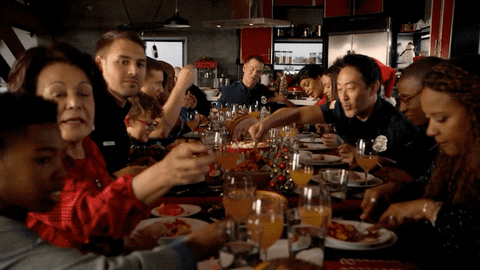 Giphy
GiphyIf nothing puts a bigger smile on your face than the thought of DoorDashing meals and barely even touching your stove during your staycation — hey, I am right there with you. Do consider going out to brunch or dinner during your chill time, though. It’s another way to bond with people and create some current holiday memories. And if you’ve got a bae and you opt for dinner, it can be a wonderful type of Christmas-themed date.
8. Go to a Holiday-Themed Concert
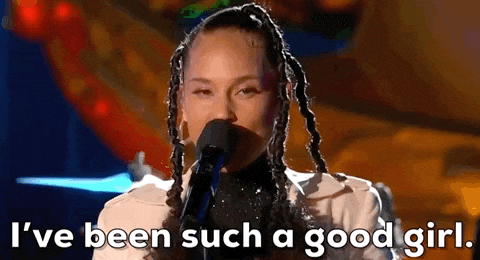 Giphy
GiphyBeing that I got my start as an entertainment writer, hear me when I say that I’m not someone who just has to go to a live concert every chance that I get. Oh, but baby, when I saw that El DeBarge was doing a City Winery tour and he was going to be here right before Christmas — I booked myself a ticket quick, fast and in a super-duper hurry! Shoot, I didn’t even want to go with someone because I plan to give him and that falsetto voice of his my complete and undivided attention. LOL.
I don’t know what it is about the holiday season that makes live music that much more enjoyable — but if there is a concert that features one of your favorite artists happening right through here, consider that to be a cool way to “tour your city” while cultivating a really awesome memory at the same time.
9. Also, Go Ice Skating
 Giphy
GiphyOne of my fondest memories of time with my father is going ice skating. We actually would do it in the summer (because that is when I would visit him) and, every year, he would get me a new ice skating outfit. Even now, when I watch someone ice skate (even in movies; like in the classic movie Garden State), I will have warm fuzzies.
Anyway, if you’ve never been before, go. If it’s been forever since you have, also go. There is something that is very sweet and so signature Christmas about it. Plus, it’s a top-tier form of exercise.
10. Take a Christmas Lights Tour
 Giphy
GiphyAnother one of my favorite Christmas memories is driving through neighborhoods and looking at the Christmas lights. And just like a Christmas concert can be a form of hometown touring, so can doing this if you decide to choose a couple of areas where you’ve never really been or rarely frequent.
Now are you excited about the thought of experiencing a holiday-themed staycation?
I thought you would be. ENJOY!
Featured image by Shutterstock

